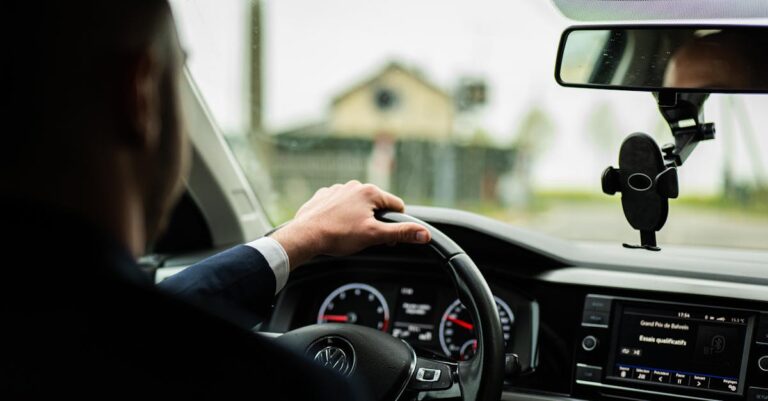Table of Contents
- Used Car Buying Checklist: Your Ultimate Guide to Avoiding Lemons
- Why Bother With a Used Car Checklist? Isn’t Trust Enough?
- Step 1: Research Before You Even See a Car
- Step 2: Initial Inspection – The Walk-Around
- Step 3: Diving Deeper – The Interior Check
- Step 4: Under the Hood – The Mechanical Heartbeat
- Step 5: The All-Important Test Drive
- Step 6: Paperwork and History Check – Don’t Skip This!
- Step 7: The Professional Inspection – Your Secret Weapon
- Final Thoughts: Trust Your Gut, But Verify Everything
- Conclusion: Driving Away Confidently
- Frequently Asked Questions (FAQs)
- FAQ 1: Can I trust a “Certified Pre-Owned” car without checking it?
- FAQ 2: What’s the single biggest red flag when buying used?
- FAQ 3: Is it rude to ask a private seller for a pre-purchase inspection?
- FAQ 4: How much should I budget for potential repairs after buying used?
- FAQ 5: What if I find a problem *after* I buy the car?
Used Car Buying Checklist: Your Ultimate Guide to Avoiding Lemons
So, you’re thinking about buying a used car? Smart move! It can save you a ton of money compared to buying new. But let’s be honest, navigating the used car market can feel like walking through a minefield. You hear the horror stories – the shiny car that turns into a money pit the moment you drive it off the lot. We call those “lemons,” and nobody wants one. How do you avoid getting stuck with a dud? Simple: you need a plan. You need a checklist. This isn’t just any checklist; it’s your shield, your guide, your secret weapon to finding a reliable ride without breaking the bank or losing your sanity. Ready to become a savvy used car buyer?
Why Bother With a Used Car Checklist? Isn’t Trust Enough?
You might think, “Can’t I just trust the seller?” Maybe you’re dealing with a seemingly nice private owner or a reputable-looking dealership. While trust is great, it’s not a substitute for due diligence, especially when thousands of dollars are on the line. Think of it like buying a house – you wouldn’t skip the inspection just because the seller seems trustworthy, right? A used car is a complex machine with countless parts, any one of which could be hiding an expensive problem.
The Hidden Costs of Skipping the Check
What happens if you skip the thorough check? You might drive away happy, only to discover a few weeks later that the transmission is slipping, the head gasket is blown, or the frame has hidden rust damage. These aren’t minor inconveniences; they’re potentially wallet-draining repairs that can easily cost more than you saved by buying used in the first place. A checklist forces you to look beyond the shiny paint and plush seats, identifying potential issues before you hand over your hard-earned cash.
Peace of Mind: Priceless
Beyond the financial aspect, using a checklist gives you invaluable peace of mind. Knowing you’ve systematically inspected the vehicle, checked its history, and ideally had a professional look it over allows you to buy with confidence. You won’t be constantly worrying about what might go wrong next. That feeling of security? You can’t put a price tag on it.
Step 1: Research Before You Even See a Car
Before you even dream of test drives, the real work begins at home, on your computer or phone. Jumping straight into looking at cars without research is like going grocery shopping hungry and without a list – you’ll likely end up with things you don’t need or that aren’t good for you (or your wallet).
Know Your Needs vs. Wants
Be brutally honest with yourself. What do you need a car for? Commuting? Hauling kids? Weekend adventures? Fuel efficiency? Cargo space? Safety features? Make a list of your absolute must-haves. Then, make a separate list of your “wants” – the sunroof, the fancy sound system, the specific color. This helps you focus your search and avoid being swayed by bells and whistles on a car that doesn’t actually suit your lifestyle or budget. How many seats do you truly require daily versus occasionally?
Reliability Ratings and Common Problems
Once you’ve narrowed down the types of vehicles that fit your needs, dive into reliability research. Resources like Consumer Reports, J.D. Power, and online owner forums are goldmines. Look up the specific makes, models, and years you’re considering. Are they known for reliability, or do they have common, expensive issues? For example, some models might be notorious for transmission failures around a certain mileage, while others might have persistent electrical gremlins. Knowing this beforehand helps you either avoid problematic models or pay extra close attention to those specific areas during inspection.
Understanding Fair Market Value
Never walk into a negotiation blind. Use online resources like Kelley Blue Book (KBB), Edmunds, or NADA Guides to determine the fair market value for the specific year, make, model, mileage, condition, and features of the car you’re interested in. Check prices for similar vehicles listed privately and at dealerships in your local area. This gives you a realistic price range and powerful leverage when negotiating. If a seller’s asking price is way above market value, you need to ask why (and be skeptical of the answer).
Step 2: Initial Inspection – The Walk-Around
Okay, you’ve done your homework and found a promising candidate. Now it’s time for the first hands-on look. Don’t rush this part. View the car in broad daylight, never at night or in the rain, as these conditions can hide flaws. Bring a friend for a second pair of eyes if possible.
Bodywork and Paint: More Than Skin Deep
Walk around the car slowly. Look at it from different angles. Does the paint color match on all panels? Variations can indicate accident repairs. Look down the sides of the car for ripples or waves in the panels, which also suggest bodywork. Check for obvious dents, dings, and scratches. Minor cosmetic flaws are expected on a used car, but significant damage is a red flag.
Checking for Rust: The Silent Killer
Rust is like cancer for cars, especially in areas with harsh winters or coastal climates. Check meticulously around wheel wells, rocker panels (the area below the doors), door bottoms, trunk edges, and around the windshield and rear window. Bring a small magnet; it won’t stick well (or at all) to areas repaired with body filler (Bondo), often used to cover rust. Poke gently (with the owner’s permission) at any suspect bubbly paint – if it flakes off easily to reveal rust, be wary. Surface rust might be treatable, but deep, structural rust is often a deal-breaker.
Panel Gaps and Mismatched Paint
Look closely at the gaps between body panels (hood and fenders, doors, trunk lid). Are they even and consistent all around? Uneven or large gaps often mean the car has been in an accident and improperly repaired. As mentioned, check paint match under sunlight. Open the doors, hood, and trunk and look for overspray on rubber seals, trim, or inside door jambs – another sign of hasty repair work.
Tires and Wheels: Where the Rubber Meets the Road
Tires are expensive, so check their condition carefully. Is the tread worn down evenly? Uneven wear (e.g., more wear on the inside or outside edges) can indicate alignment problems, which might stem from worn suspension components or even frame damage. Check the tire sidewalls for cracks, bulges, or cuts. Look at the DOT code on the sidewall to determine the tire’s age (the last four digits represent the week and year of manufacture; e.g., 3219 means the 32nd week of 2019). Tires older than 6-7 years may need replacing soon, regardless of tread depth. Don’t forget the spare tire and the jack/tools! Check the wheels (rims) for cracks, curb rash, or bends.
Glass and Lights: Cracks, Chips, and Clarity
Inspect all glass – windshield, side windows, rear window – for cracks, large chips (especially in the driver’s line of sight, which might fail inspection), and excessive pitting. Check the headlights and taillights for cracks, fogging (moisture inside), or haziness. Turn on all the lights (headlights low/high beam, parking lights, taillights, brake lights, turn signals, hazard lights) to ensure they work correctly. Replacing modern headlight assemblies can be surprisingly expensive.
Step 3: Diving Deeper – The Interior Check
Now, open the doors and get inside. The interior can tell you a lot about how the car was treated by its previous owner(s).
Smells and Stains: Sniffing Out Trouble
Take a good sniff. Does it smell musty or moldy? This could indicate water leaks, possibly from bad seals or even flood damage (a major red flag!). Heavy air freshener use might be trying to mask unpleasant odors like cigarette smoke, pet smells, or mold. Check the carpets (lift the floor mats), upholstery, and headliner for significant stains, rips, tears, or burns. Look under the mats for dampness or rust on the floor pan.
Electronics and Features: Do They All Work?
This is where you need to be methodical. Turn the key to the “on” position (without starting the engine) and check that all the dashboard warning lights illuminate briefly and then turn off. If any stay on (like the Check Engine light, ABS, or Airbag light), it signals a problem. Then, start the engine and test everything:
- Radio and speakers
- Air conditioning (does it blow cold?)
- Heater (does it blow hot?)
- Windshield wipers and washers (front and rear if applicable)
- Power windows and locks
- Power mirrors
- Sunroof (does it open, close, and seal properly?)
- Seats (power adjustments, heaters/coolers)
- Horn
- Any other specific features the car has (navigation, backup camera, etc.)
Don’t be shy – press all the buttons! Fixing faulty electronics can be tricky and costly.
Step 4: Under the Hood – The Mechanical Heartbeat
With the engine off and ideally cool (or at least not piping hot), pop the hood. You don’t need to be a master mechanic, but some basic checks can reveal potential issues. Look for general cleanliness – a filthy engine bay might suggest neglect, while a suspiciously spotless one could mean the seller steam-cleaned it to hide leaks.
The Lifeblood of the Car
Checking fluids is crucial. Locate the dipsticks and reservoirs:
- Engine Oil: Pull the dipstick, wipe it clean, reinsert it fully, then pull it out again. Check the level – is it between the ‘Min’ and ‘Max’ marks? Note the color and consistency. Healthy oil is typically amber or dark brown. Very black, thick oil is overdue for a change. Milky or frothy oil (like coffee with too much cream) indicates coolant leaking into the oil – often a sign of a blown head gasket, a very expensive repair. Smell it – does it smell burnt?
- Transmission Fluid: Many automatic transmissions have a dipstick (check the owner’s manual for the correct procedure – some need the engine running and warm). Fluid should be reddish or pink and smell slightly sweet. Brown, dark, or burnt-smelling fluid indicates potential transmission problems.
- Brake Fluid: Check the level in the reservoir. The fluid should be relatively clear or light amber. Dark, murky fluid needs changing.
- Power Steering Fluid: Check the level in its reservoir.
- Coolant (Antifreeze): Check the level in the overflow reservoir (don’t open the radiator cap when the engine is hot!). Look at the color – it should be bright green, orange, pink, or blue, depending on the type. Rusty or oily coolant suggests internal engine problems.
Belts, Hoses, and Battery: Signs of Wear
Visually inspect the rubber belts (serpentine belt, timing belt if visible) for cracks, fraying, or glazing. Squeeze the larger coolant hoses – they should feel firm but not rock hard or mushy. Look for bulges, cracks, or leaks around the clamps. Check the battery terminals for corrosion (a white or bluish powdery buildup). Look for a date sticker on the battery; most car batteries last 3-5 years. If it’s old, budget for a replacement soon.
Step 5: The All-Important Test Drive
This is arguably the most critical part of the inspection. Aim for at least 15-20 minutes, covering various conditions: city streets, stop-and-go traffic, and highway speeds if possible.
Starting Up and Listening Closely
Listen carefully when the engine starts. Does it start easily, or does it crank excessively? Listen for any immediate strange noises – clicks, ticks, knocks, or rattles. Once running, listen to the engine idle. Is it smooth, or rough and shaky? Listen to the exhaust – any loud rumbling, hissing, or popping sounds?
How Does It Handle? Steering and Brakes
Pay attention to how the car feels. Does the steering feel overly loose or tight? Does the car pull to one side when driving straight (let go of the wheel briefly on a flat, straight road)? Are there any clunks or strange noises when turning the wheel or going over bumps? Test the brakes in various situations. Do they feel firm and responsive, or soft and spongy? Does the car pull to one side when braking hard? Do you hear any grinding or squealing noises? Does the brake pedal pulsate (often indicating warped rotors)?
Transmission Test: Smooth Sailing or Rough Waters?
Whether automatic or manual, the transmission should shift smoothly.
- Automatic: Does it shift up and down through the gears without hesitation, harsh clunks, or slipping (engine revs up but car doesn’t accelerate proportionally)? Try accelerating moderately and then more briskly. Try coming to a stop and accelerating again.
- Manual: Does the clutch engage smoothly without grabbing or slipping? Is the pedal travel normal (not too high or too low)? Does the shifter move easily into all gears without grinding?
Listen for any whining or humming noises that change with engine speed or gear selection.
Step 6: Paperwork and History Check – Don’t Skip This!
The car might look and drive great, but its past can hold nasty surprises. Verifying the paperwork is non-negotiable.
Vehicle History Report (VIN Check)
Get the Vehicle Identification Number (VIN) – usually found on the dashboard (visible through the windshield on the driver’s side) and on a sticker in the driver’s doorjamb. Run a vehicle history report through services like CarFax or AutoCheck. This report can reveal:
- Accident history (though not all accidents get reported)
- Title issues (salvage, flood, lemon law buyback)
- Ownership history
- Reported mileage (check for inconsistencies or rollback)
- Service records (sometimes)
- Whether it was used as a rental or fleet vehicle
While not foolproof, a clean report is reassuring, and a problematic report is a definite reason to walk away or investigate much further.
Title Check: Clean, Salvage, or Flood?
Ask to see the vehicle’s title (ownership document). Ensure the seller’s name is on the title. Check the title status carefully. A “clean” title is what you want. Be extremely cautious of titles branded as “Salvage,” “Rebuilt,” “Flood,” “Fire,” or “Lemon.” These cars have sustained significant damage, and while they might be repaired and cheaper, they often come with hidden, persistent problems and may be difficult to insure or resell. Does the VIN on the title match the VIN on the car?
Step 7: The Professional Inspection – Your Secret Weapon
Even if you’re meticulous, you’re likely not a trained mechanic. Before you agree to buy, especially from a private seller or small dealership, invest in a pre-purchase inspection (PPI). For around $100-$200, you can have an independent mechanic put the car up on a lift and give it a thorough examination. They can spot things you might miss, like frame damage, imminent mechanical failures, leaky seals, or hidden rust. Think of it as insurance against buying a lemon. If the seller refuses to allow a PPI at your expense, consider that a massive red flag and walk away. A good mechanic’s report can confirm your decision to buy, give you leverage to negotiate the price down based on needed repairs, or save you from making a costly mistake.
Final Thoughts: Trust Your Gut, But Verify Everything
Buying a used car involves blending objective checks with subjective feelings. Go through this checklist systematically for every car you seriously consider. Don’t let a slick salesperson or a desperate-seeming private seller rush you. Take your time. If something feels off, even if you can’t pinpoint why, trust your intuition. Maybe the seller’s story doesn’t quite add up, or the car just has a “weird vibe.” It’s better to walk away from a potential deal than to be stuck with a car you regret. Remember the golden rule: trust, but verify everything.
Conclusion: Driving Away Confidently
Finding a great used car isn’t about luck; it’s about preparation and diligence. By following this comprehensive checklist – from initial research and thorough walk-arounds to interior checks, mechanical inspections, test drives, paperwork verification, and crucially, a professional pre-purchase inspection – you drastically reduce your chances of buying a lemon. You empower yourself with knowledge, identify potential problems early, and gain negotiating power. It might seem like a lot of steps, but the effort invested upfront will pay dividends in reliability, safety, and peace of mind down the road. Now go out there, use your checklist, and find that perfect-for-you used car with confidence!
Frequently Asked Questions (FAQs)
FAQ 1: Can I trust a “Certified Pre-Owned” (CPO) car without checking it?
A: While CPO programs offer benefits like extended warranties and multi-point inspections performed by the dealership, they aren’t foolproof. Standards can vary between manufacturers, and sometimes issues are missed or overlooked. It’s still highly recommended to do your own walk-around, test drive thoroughly, review the vehicle history report, and ideally, get an independent PPI for maximum assurance. Think of CPO as an added layer of potential security, not a replacement for your own due diligence.
FAQ 2: What’s the single biggest red flag when buying used?
A: It’s tough to pick just one, but a branded title (Salvage, Flood, Lemon) is a massive red flag indicating severe past issues. Another huge one is a seller (private or dealer) who refuses to allow an independent pre-purchase inspection (PPI). This almost always suggests they know something is wrong with the car and don’t want a mechanic to find it. Run, don’t walk!
FAQ 3: Is it rude to ask a private seller for a pre-purchase inspection?
A: Absolutely not! A reasonable private seller who is confident in their vehicle should have no problem with you arranging and paying for a PPI at a nearby mechanic. It shows you’re a serious buyer doing your homework. If they resist strongly or make excuses, that’s a major warning sign. Frame it politely: “I’m very interested in the car, and as a final step, I’d like to have my mechanic take a look at it for peace of mind. I’ll cover the cost, of course.”
FAQ 4: How much should I budget for potential repairs after buying used?
A: It’s wise to set aside a contingency fund, even if the car checks out well. No used car is perfect. A general rule of thumb is to budget at least $500-$1000 for potential initial maintenance (like fluid changes, maybe new brake pads, or a minor fix) or unexpected repairs that might pop up shortly after purchase. If the PPI identified specific upcoming needs (like tires soon), factor those costs in more precisely.
FAQ 5: What if I find a problem *after* I buy the car?
A: Your options depend heavily on where and how you bought the car and your location’s laws. Private sales are almost always “as-is,” meaning once you buy it, the problems are yours unless you can prove the seller committed outright fraud (which is very difficult). Dealerships may offer limited warranties, or you might have purchased an extended warranty. Some states have “lemon laws” for used cars, but the criteria are often strict. Your best protection is prevention – doing the thorough checks before buying.









